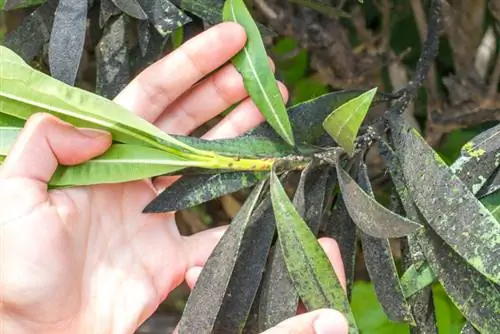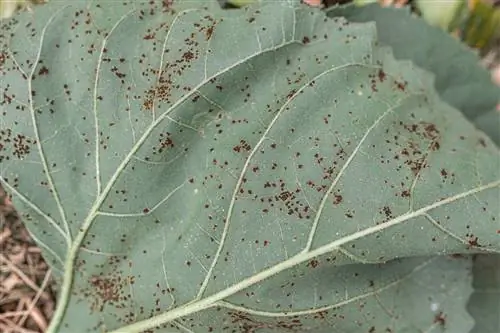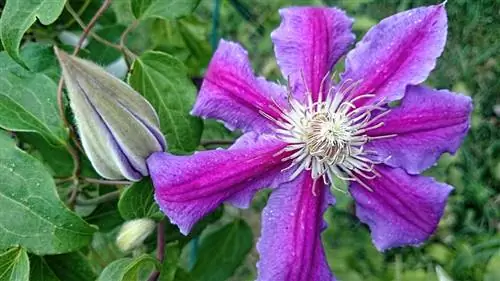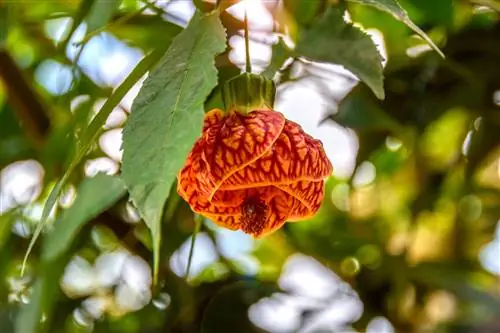- Author admin [email protected].
- Public 2023-12-16 16:46.
- Last modified 2025-01-23 11:20.
Unfortunately, the oleander is not only beautiful to look at, but is also quite susceptible to lice infestation. Not only do the ubiquitous aphids like the Mediterranean ornamental shrub, but also the mealybugs and scale insects that are often found on potted plants. You can read how to identify the different plant lice and ultimately fight them in this article.
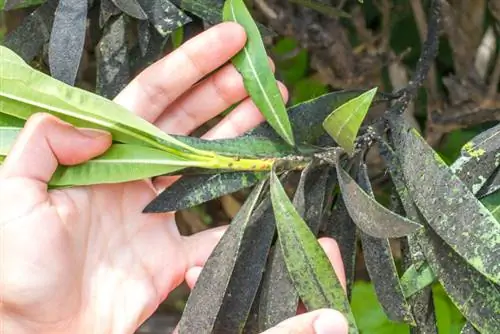
How do you fight lice on oleander?
To combat oleander aphids, remove aphids with a jet of water and use nettle manure. Treat scale insects with soft soap or rapeseed oil. You can fight mealybugs in a similar way to scale insects; neem oil products are particularly effective here.
Aphids
Aphids are not particularly picky when it comes to their choice of food; they take what they can get. The small, black, green or yellow animals, depending on the species, inhabit almost every leafy plant, including of course the oleander. The yellow aphids in particular feel very comfortable here. The harmful insects can be found on all soft parts of plants, i.e. H. especially on the fresh shoots and inflorescences. Since the older leaves of the oleander are quite hard, they cannot be pierced by the animals' stinging proboscis. Aphids themselves don't cause much damage; their sticky-sweet excretions are particularly damaging. The so-called honeydew serves as a food source for both ants and various fungi (especially the sooty mold fungus). But by the time you can identify an aphid infestation thanks to migrating ant colonies and black leaf covers, the annoying little beasts have already multiplied diligently. It is therefore important to check the oleander regularly for lice infestation.
What you can do
Aphids are fortunately quite easy to combat. First of all, spray your infected oleander with a strong jet of water, this will effectively drive away the animals. However, make sure that the bush can dry well and quickly afterwards - otherwise there will be a fungal infection afterwards. A spray treatment with home-made nettle manure is also very effective against aphids. This also offers the advantage of strengthening the plant's own defenses. If none of this helps, you can find very effective anti-aphid agents in specialist shops (€9.00 on Amazon).
Scale insects
Scale insects also often settle on oleanders and, like aphids, are after the nutritious plant sap. There are different species, but they all have the protective shield in common. This can be white, brown or even humpbacked and black-brown. Due to their protective shield, scale insects are much more difficult to combat than aphids, but they can also be effectively killed using simple means. You can find the animals mainly on the undersides of the leaves and on the older shoots.
What you can do
Simple preparations such as soft soap or rapeseed oil have proven particularly effective against scale insects. Both agents ensure that the animals suffocate and are therefore rendered harmless. Spray the affected areas with a mixture of water, a dash of dishwashing liquid (or a little soft soap) and a dash of rapeseed oil.
Mealybugs
Mealybugs are rarely found on oleander plants, but are mentioned here for the sake of completeness. You can recognize a mealybug infestation by the cotton-like, white coating that appears primarily on the leaves and soft shoots.
What you can do
Mealybugs are combated in the same way as scale insects, although products based on neem oil are also very effective.
Tip
If there is a severe scale insect or mealy bug infestation, it is advisable to cut back the oleander. The plant then offers less surface area to attack and you can get rid of a large part of the annoying animals that are difficult to remove.

